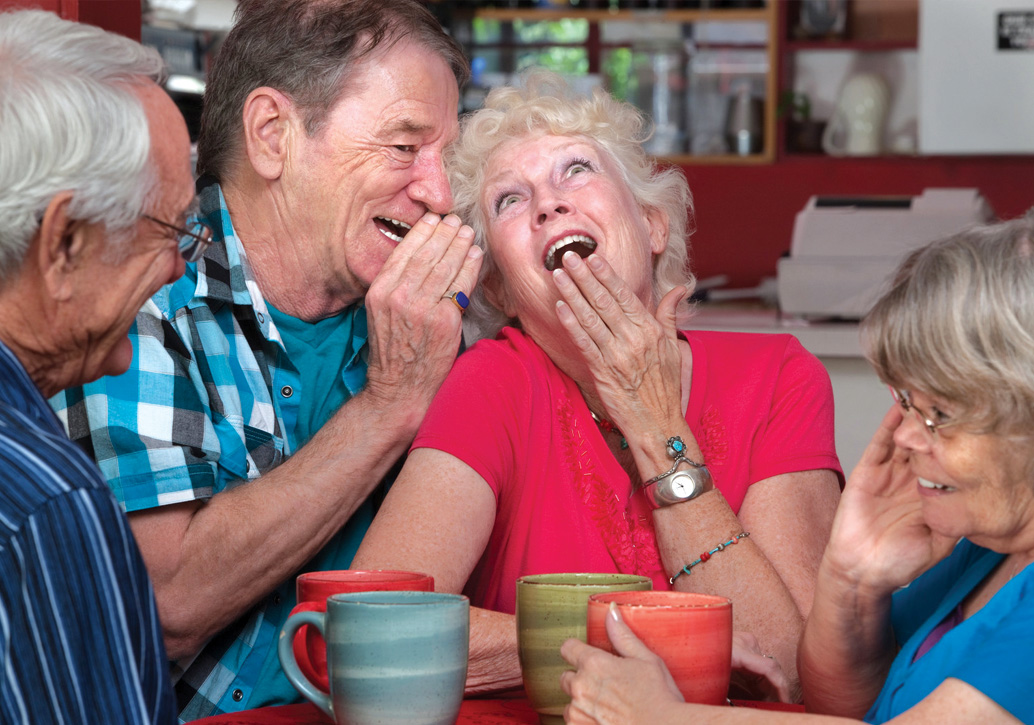By Helen Hunter
The scientific definition of laughing is a “successive, rhythmic, spasmodic expiration with open glottis and vibration of the vocal cords, often accompanied by baring of the teeth and facial expression.” This doesn’t begin to tell the story of what laughing actually does for us, however. The bottom line: Laughing is good for us.
Bringing people together
Laughter establishes, or restores, a positive emotional climate and a sense of connection between two people. In fact, some researchers believe that the major function of laughter is to bring people together—the more social a person is and the more social support a person receives, the more likely that laughter will result from that social connection. Mutual laughter and play are essential components of strong, healthy relationships. By making a conscious effort to incorporate more humour and play into your daily interactions, you can improve the quality of your relationships.
Physical effects of laughing
Laughing makes people feel good for a reason. Studies have shown that it boosts the immune system and triggers the release of pleasure-inducing neurochemicals in the brain. The immune system, which contains special cells that are responsible for defending the body against infection, has been shown to strengthen during the act of laughing. In the central nervous system, our brains release powerful endorphins when we laugh. Endorphins are natural, morphine-like compounds that raise the pain threshold, produce sedation and induce euphoria (commonly called a “natural high”). In other words, we feel better when we laugh because endorphins reduce physical and mental pain. While this may be a wonderful feeling, laughing has other benefits as well.
 During a laugh, our respiration, heart rate and blood pressure temporarily rise. This causes oxygen to surge through the bloodstream to lower the blood pressure. Laughter therefore improves the function of blood vessels and increases blood flow, which can help protect against a heart attack and other cardiovascular problems. Laughter also reduces pain and allows for greater toleration of discomfort—and decreases blood sugar levels.
During a laugh, our respiration, heart rate and blood pressure temporarily rise. This causes oxygen to surge through the bloodstream to lower the blood pressure. Laughter therefore improves the function of blood vessels and increases blood flow, which can help protect against a heart attack and other cardiovascular problems. Laughter also reduces pain and allows for greater toleration of discomfort—and decreases blood sugar levels.
Healthy relaxation
Our whole body relaxes during laughter, relieving tension and stress. It has been shown that following a good, hearty laugh, muscles in the body are relaxed for up to 45 minutes afterwards. Laughing burns calories—sometimes being referred to as “inner jogging.” A hearty laugh gives the muscles of the face, chest, shoulders, stomach and diaphragm a good workout.
Laughter also helps to create a positive mood. It allows the expression of happiness and the release of anxiety. Humour eases tension and is often a great antidote to a stressful situation, as it tends to shut off certain hormones that are released during such circumstances. In fact, your sense of humour is one of the most powerful tools you have to make certain that your daily mood and emotional state support good health.
Nine ways to bring laughter into your life
Smiling is the beginning of laughter. Like laughter, it’s contagious. When you look at someone or see something even mildly pleasing, practise smiling!
1) Count your blessings. Literally make a list. The simple act of considering the good things in your life will distance you from negative thoughts that are a barrier to humour and laughter!
considering the good things in your life will distance you from negative thoughts that are a barrier to humour and laughter!
2) When you hear laughter, move toward it. People are very happy to share something funny because it gives them an opportunity to laugh again and feel the humour in it. When individuals hear laughter, they seek it out and ask “What’s funny?”
3) Spend time with fun, playful people. These are people who laugh easily, both at themselves and at life’s absurdities, and who routinely find humour in everyday events. Their playful point of view and laughter are contagious!
4) Bring humour into conversations. Ask people: “What’s the funniest thing that happened to you today? This week? In your life?” Laugh at yourself. Share your embarrassing moments.
5) Attempt to laugh at situations rather than bemoan them. Look for the humour in a bad situation, the irony and absurdity of life. This will help improve your mood and the mood of those around you.
6) Surround yourself with reminders to lighten up. Keep a toy on your desk or in your car. Put up a funny poster in your office. Choose a computer screensaver that makes you laugh. Frame photos of you and your family having fun.
7) Keep things in perspective. Many things are beyond our control, so make the best of a situation and find the positive in the situation. Also learn to deal with stress. Stress is a major impediment to humour and laughter.
8) Pay attention to children and emulate them. Children are the experts on playing, taking life lightly and laughing!!
9) My simple prescription for a healthy life: Thirty minutes of exercise at least three times a week, and 15 minutes of laughter on a daily basis! The bottom line—laughter may just be the best medicine on the market today!
Reprinted with permission from the author.
Helen Hunter, ACSW, LSW, is an independent geriatric social worker, consultant trainer, author and spiritual director. She is also a licensed social worker.













